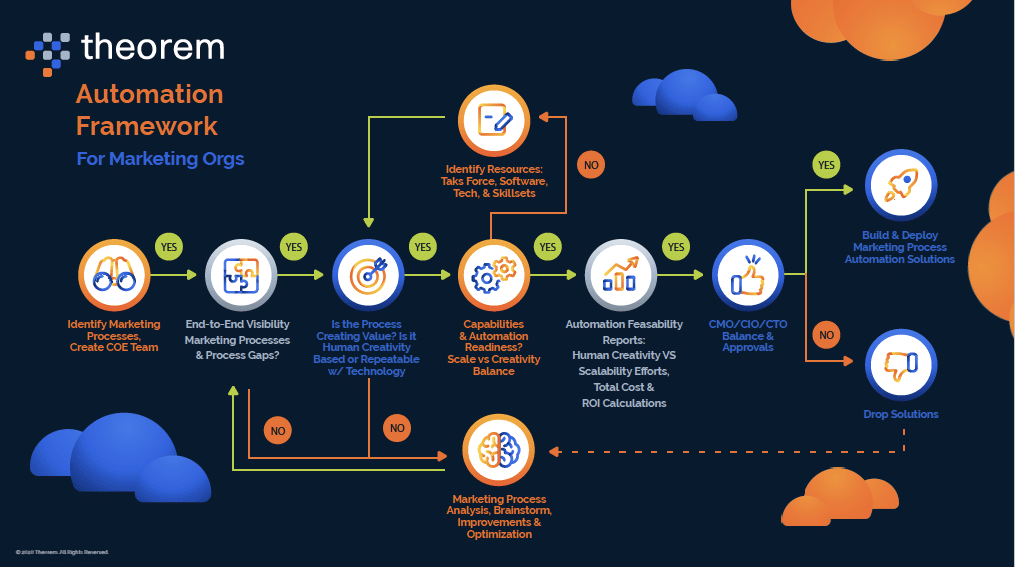In part one of our series, we explained why the automation of marketing processes has become a competitive imperative for all brands and businesses. In this post, we’ll discuss the key components digital marketers must consider in order to embark on a successful marketing automation journey.
The Importance of Creating a Future State
Before an organization can implement any kind of useful automation strategy, they must establish a well-defined and achievable set of objectives and goals for the business as a whole.
This future state vision is vital for creating sustainable automation practices–without it, only short-term pains can be solved if anything at all.
An organization may not yet have a full understanding of the uncertainties and wild cards of their business, for example. Or the maturity levels of the market may differ significantly from what has already been put in place internally. Whatever the variable, businesses need to work backward from a clearly delineated future state to create a strategic plan that brings value to the entire organization.
Future-state analysis needs to take a number of factors into account, including existing skills, a fit-gap analysis of skills that will impact reskilling and upskilling, and career pathing for employees who are impacted. You’ll also need to consider savings over a one-, two-, and three-year horizon, the budget for technology licensing, the impact of client-facing pricing and its impact on overall ROI, and the overall impact on an organization’s ongoing operating model based on automation.
This is particularly critical for direct marketing organizations, data base marketers, and traditional agencies, as the majority tend to be stifled by legacy. Disrupting existing processes will inevitably cause contention and create pushback, especially if they’re working well in the here and now.
You will be met with resistance and it will be a challenge to arbitrage, which is why it’s impossible to pivot overnight. But if you know these changes are necessary for your business to scale when looking at it from a future state, the challenge must be faced and taken head-on.
Looking at the Automation Journey Holistically
Over the last two to three years, many Fortune 1000 companies have started to see automation as a strategic imperative. Acquiring and retaining talent is becoming very expensive, and manual tasks are becoming commoditized or simply not scaling. In addition, many of the cutting-edge technologies that help with automation, including cryptocurrency, machine learning, AI, and big data, are becoming more affordable and accessible.
Getting the journey started now is critical for these reasons, and the best way to begin is by utilizing hyper-automation.
This approach involves looking at an organization holistically across multiple departments, identifying as many business processes as possible, and with the organization’s future state as the main objective, using a combination of tools to automate them.
One type of automation will not work for each and every process, so comprehensive tech stacks must be developed across the entire organization. A mix of technologies, packaged software, machine learning, and infrastructure will be necessary to deliver the work.
For example, say an ad operations team determines the need to automate a manual process like ad trafficking for a specific client due to the volume of ads. In addition to creating a solution for pain points specific to that group and that specific project (the man hours spent and margin of error introduced when manually transferring ad links and adding tags), a successful, future-state-conscious automation strategy will also work across the entire ad op teams for other clients. When viewed holistically, it can be universally applied and scalable across the entire organization.
Take BPOs and call centers, for example. As voice recognition software has become increasingly accessible and mainstream, these types of organizations have had to rapidly adapt in order to scale.
Now, the majority have created workflows that can recognize the human voice associated with a specific account, enabling calls to bypass human interaction entirely.
Back-Office Automation
Many companies are also automating their “back offices,” which refers to processes that are not client-facing and do not impact the market. This low-risk approach gives organizations the opportunity to build and develop automation processes internally, without having to worry about significant revenue damage if the strategy fails.
Human resource departments serve as a good example. Both recruitment and employee onboarding are process-driven tasks with many manual components.
From posting job descriptions and mining for resumes, to handing out and filing benefit forms, automation simplifies and scales these processes so that large volumes can be handled faster, more efficiently, and with less error.
Comprised of key stakeholders across all areas of an organization, a center of excellence (CoE) works across business units to provide leadership, share best practices, and improve overall efficiency. Establishing a strong CoE is a critical precursor to the automation journey, as this team is responsible for developing and driving the business’s all-important future state.
Making the Journey Real for Teams: Building Your Center of Excellence
Comprised of key stakeholders across all areas of an organization, a center of excellence (CoE) works across business units to provide leadership, share best practices, and improve overall efficiency. Establishing a strong CoE is a critical precursor to the automation journey, as this team is responsible for developing and driving the business’s all-important future state.
It can be helpful to think of the CoE as the gutters along the sides of a bowling lane. Their purpose is to provide the bowler (i.e. a company’s teams) with guidelines for aiming the ball (i.e. a set of tech tools) down the lane. The pins are the company’s future state, and if the execution is successful, the ball will reach the pins without falling into the gutter. Whether there’s a strike, a spare, or a split will depend on the bowler’s aim and execution. The CoE sets the guidelines while the teams execute the plans.
In other words, the COE will map your business’s existing state and future state, and balance the transition from what’s working well in the now to the gradual adaptation of what will work in the future at scale. They’ll also take human creativity into account—your company’s “secret sauce,” so to speak—when determining what does and does not need to be automated.
Expectations of Success & Organizational Adaptation
Speaking of that “secret sauce,” you can use it as a general guideline for evaluating automation need. If human creativity is your organization’s secret sauce—i.e. the main ingredient driving revenue and growth—automation may not be right for you. But if you have many repetitive tasks and/or elements that have been commoditized, it’s a tactic to strongly consider. Success metrics for implemented automation processes can be measured in two phases–internal, then external.
In terms of the first phase, it’s okay if internal back-office processes fail because they are not impacting the market or revenues. But eventually, an organization will have to automate externally in order to have a real ROI.
Based on the success of their internal automation, the organization will need to figure out how to turn their strategies outward to create front-office, market-facing processes. That’s when the automation journey becomes fully holistic and the businesses can arrive at its true future state.
It’s also important to make sure individuals across the organization are aligned with the automation journey.
This is critical, as there is always resistance – especially in the case of employees who fear losing their jobs. Properly educating the workforce is essential for encouraging this mindset change, as is investing in career pathing, re-skilling, and other professional development rewards.
In Conclusion
When embarking on an automation journey, you should never lead with technology.
Instead, focus on creating a solid CoE that provides a framework for implementation and evaluation. Doing so will greatly improve your automation success.









